- Last Updated: November 24th, 2025
Key Takeaways
PCB exposure can lead to a variety of health concerns, necessitating thorough health monitoring.
Those at higher risk include individuals living near contaminated sites and those with occupational exposure to PCBs.
Health surveillance is a tool for early detection of PCB-related health complications.
Overview of PCB Exposure Victims
On this page, we’ll discuss an overview of PCB exposure victims, long-term health monitoring for individuals exposed to PCBs, the importance of medical surveillance for PCB exposure victims, and much more.
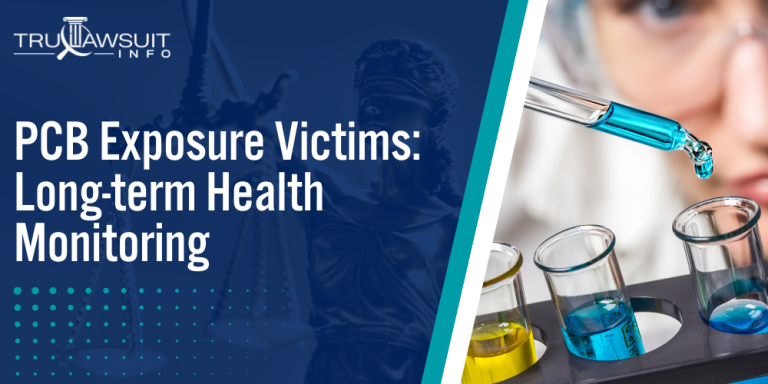
Intro to PCB Exposure Victims
Here are the different ways PCBs can enter the body:
- Occupational Exposure: Before the bans in 1979, workers in industries such as electrical equipment repair or manufacturing were particularly susceptible to inhaling or dermal contact with PCBs.
- Environmental Exposure: Individuals may come across PCBs through contaminated soil or old electrical transformers or other fixtures unwittingly left in the environment.
- Contaminated Food: PCBs are often ingested through the consumption of PCB-contaminated fish and other contaminated food sources.
- Health Concerns: PCB exposures have been linked to a range of adverse health effects, including but not limited to reproductive and developmental effects, immune system damage, liver damage, and an increased risk of cancer mortality.
If you or a loved one has experienced adverse health conditions after being exposed to PCB chemicals, you may qualify to pursue compensation.
Contact TruLawsuit Info using the chat on this page to receive an instant case evaluation to determine if you qualify to file a PCB lawsuit today.
Health Effects of PCB Exposure
Polychlorinated biphenyls (PCBs) are toxic substances known for their harmful health effects on humans.
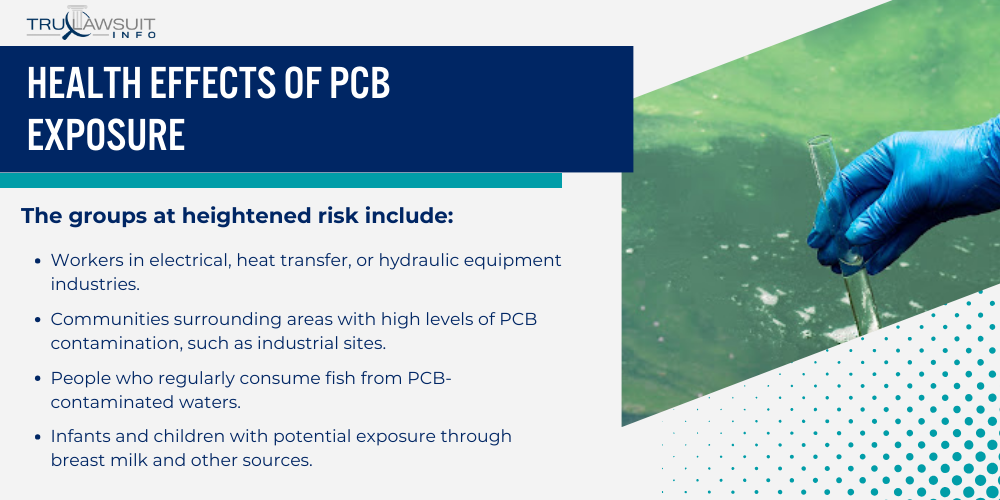
They have been classified as probable human carcinogens and can cause a variety of adverse health effects.
These substances have the potential to increase the risk of developing serious health conditions, such as liver damage, immune system compromise, and reproductive and developmental effects.
Populations at Risk of PCB Exposure
Populations at risk of PCB exposure include individuals in certain occupations, residents near contaminated sites, and consumers of fish from contaminated lakes.
The extent of health effects can depend on the level and duration of exposure.
The groups at heightened risk include:
- Workers in electrical, heat transfer, or hydraulic equipment industries.
- Communities surrounding areas with high levels of PCB contamination, such as industrial sites.
- People who regularly consume fish from PCB-contaminated waters.
- Infants and children with potential exposure through breast milk and other sources.
Historical Cases of PCB Exposure
Historical cases of PCB exposure reveal the serious and varied harmful health effects caused by these chemicals.
Two significant incidents of mass PCB poisoning occurred in Japan and Taiwan.
Notable cases of PCB exposure include:
- The Yusho incident in Japan in 1968 caused skin disorders and systemic symptoms among many people after consuming rice oil contaminated with PCBs.
- The Yu-Cheng poisoning in Taiwan in 1978 also stemmed from PCB-contaminated food, resulting in various health problems for the exposed population.
- Occupational studies have suggested an association between PCB exposure and chronic health effects in electrical industry workers.
- Epidemiological research has linked PCB exposure to increased risks of certain types of cancer and other long-term health conditions.
By reviewing these historical cases, researchers have enhanced their understanding of the extended impact PCBs have on human health, prompting better regulations and preventative measures against PCB exposure.
Importance of Long-term Health Monitoring for PCB Exposure Victims
Long-term health monitoring is essential for individuals exposed to PCBs due to the potential for serious health problems that can develop over time, including liver cancer and breast cancer.

Early Detection of PCB-related Health Issues
Detecting PCB-related health issues early can lead to better patient outcomes.
Early detection involves vigilant monitoring for signs of exposure-related health concerns, such as reproductive, developmental, and neurological symptoms.
By catching these issues promptly, interventions can be more effective.
Here are some key methods for early detection of PCB-related health issues:
- Annual check-ups: Regular health assessments can spot early signs of trouble.
- Blood tests: These can reveal elevated PCB levels that might not otherwise be noticed.
- Cancer screenings: Essential for detecting cancers like liver and breast cancer at a stage when they are more treatable.
- Neurological evaluations: Tests can identify early neurological symptoms connected to PCB exposure.
Tracking the Progression of PCB-related Diseases
Monitoring the progression of diseases in PCB exposure victims is vital to adjusting treatments effectively.
Tracking diseases provides data on how health problems evolve and respond to treatment.
Here are some methods for tracking the progression of PCB-related diseases:
- Detailed medical records: Keeping thorough records helps doctors see disease progression over time.
- Regular imaging tests: Scans can monitor any changes in tissues or organs.
- Symptom diaries: Patients can track their own symptoms, providing valuable information to healthcare providers.
- Follow-up with specialists: Regular consultations help manage and adjust treatments as needed.
Identifying Patterns and Trends in PCB Exposure Victims
Understanding patterns in PCB exposure can inform public health policies and lead to better protective measures.
Identifying trends requires meticulous collection and analysis of statistical data.
Here are some key methods for identifying patterns and trends in PCB exposure:
- Epidemiological studies: These explore connections between PCB exposure and health outcomes.
- Cohort tracking: Following groups of exposed individuals over time can reveal crucial information.
- Geographic data analysis: Helps determine if certain areas have higher rates of PCB-related illnesses.
- Occupational studies: Exposed workers in some industries may have higher exposure risks, informing workplace safety changes.
Components of a Comprehensive Long-term Health Monitoring Program
Victims of PCB exposure require a multi-faceted approach to health monitoring to manage the long-term effects.

This includes medical oversight, biomonitoring, mental health support, and lifestyle adjustments.
Regular Medical Check-ups and Screenings
Regular medical check-ups and health screenings are essential for the early detection and management of potential health issues caused by PCB exposure.
They generally include:
- Evaluation of medical history and symptom progression.
- Physical examinations to assess current health status.
- Routine cancer screenings, considering the increased risk due to PCB transformers and exposure.
- Regular blood tests to monitor organ function and detect abnormalities.
Biomonitoring for PCB Levels
Monitoring PCB levels in the body, known as biomonitoring, helps track exposure over time.
Key components of this process include:
- Blood tests to measure current levels of PCBs.
- Comparing PCB levels against established safety benchmarks.
- Documenting changes in PCB concentration in the body.
- Utilizing PCB biomonitoring data to tailor patient health plans.
Mental Health Support and Counseling
Mental health support and counseling services provide the necessary care to address the psychological impact.
Vital services should incorporate the following:
- Regular evaluations for signs of depression, anxiety, and other mental conditions.
- Access to counseling sessions for emotional support.
- Programs designed to enhance emotional well-being and cope with stress.
- Support groups to connect individuals with similar experiences for peer encouragement.
Lifestyle and Nutritional Guidance
Offering lifestyle and nutritional guidance is pivotal for promoting healthier living.
Essential advice should cover:
- Dietary recommendations to boost the immune system and minimize toxin intake.
- Exercise routines tailored to improve physical health and reduce PCB-related risks.
- Strategies for avoiding re-exposure to commercial PCB mixtures and other harmful substances.
- Education on the importance of a healthy lifestyle in mitigating the consequences of PCB exposure.
Challenges in Implementing Long-term Health Monitoring for PCB Exposure Victims
Long-term health monitoring for victims of PCB (polychlorinated biphenyls) exposure faces several hurdles.
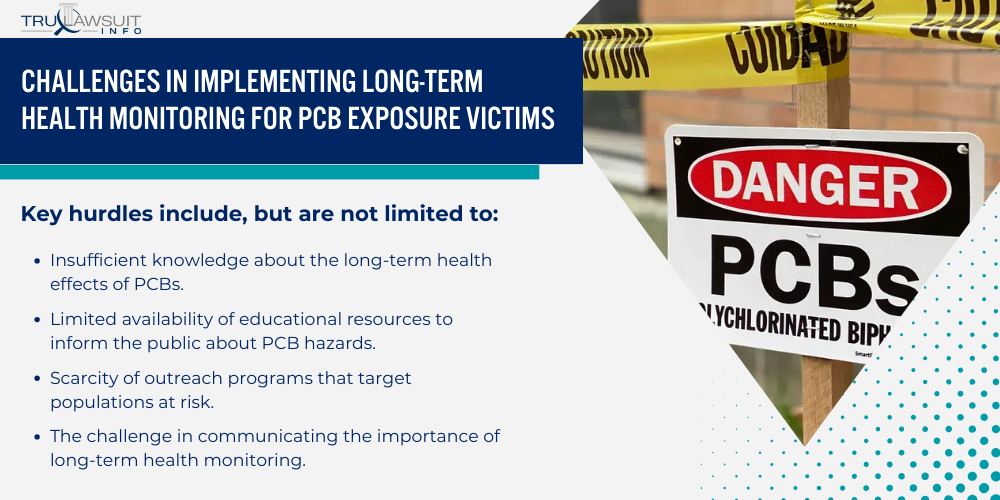
A combination of societal and systemic factors hampers effective surveillance.
Lack of Awareness and Education
Victims of PCB exposure often encounter a lack of public awareness and education on the potential risks associated with these chemicals.
Key hurdles include:
- Insufficient knowledge about the long-term health effects of PCBs.
- Limited availability of educational resources to inform the public about PCB hazards.
- Scarcity of outreach programs that target populations at risk.
- The challenge in communicating the importance of long-term health monitoring.
Limited Access to Specialized Healthcare Services
Specialized healthcare services are crucial for monitoring PCB exposure victims.
They face:
- A shortage of clinicians skilled in treating complex, chronic conditions resulting from PCBs.
- Geographic disparities in the availability of specialized services.
- Difficulty in establishing continuity of care for those requiring long-term monitoring.
- There is a need for more comprehensive healthcare networks that are accessible to all patients.
Financial Barriers and Inadequate Insurance Coverage
Individuals may face significant out-of-pocket costs for PCB-related healthcare, even with insurance.
Additionally, some insurance plans may not cover all necessary aspects of PCB exposure monitoring and treatment.
This can create a significant financial burden for people seeking care.
Financial barriers and insufficient insurance coverage further complicate access to healthcare:
- High out-of-pocket costs for consultations and long-term treatment.
- Insurance plans that may not cover all aspects of PCB exposure monitoring.
- The challenge in obtaining approval for specialized tests and treatments.
- Struggle with financial support for ongoing medical follow-ups.
Social Stigma and Discrimination
Victims of PCB exposure may also face social stigma and discrimination, leading to reluctance to seek care.
This includes:
- Perception of PCB-related illnesses within communities.
- The marginalization of affected individuals inhibits them from seeking help.
- Discrimination in the workplace or social settings, particularly for visible conditions like chloracne.
- The impact of mental health stigma on individuals seeking psychosocial support.
Benefits of Long-term Health Monitoring for PCB Exposure Victims
Long-term health monitoring is an integral aspect of managing the effects of PCB exposure.
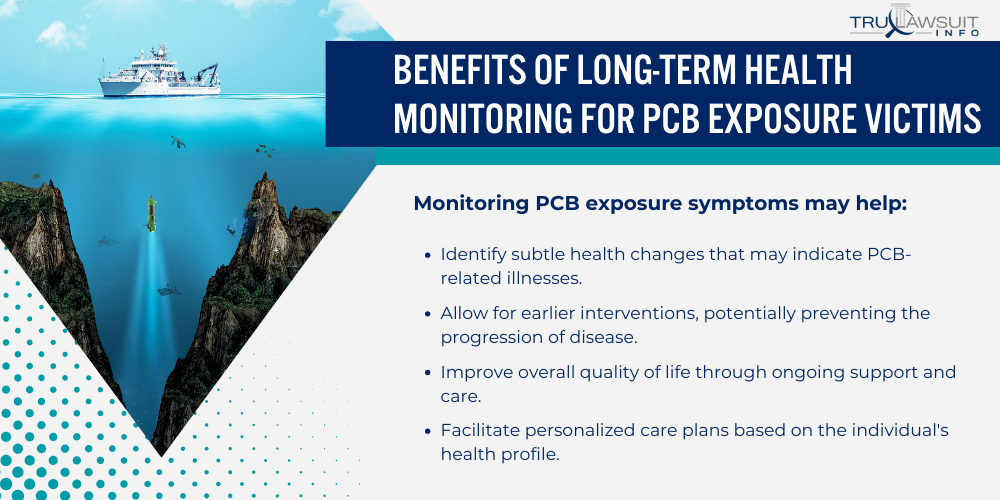
It enables timely intervention and provides vital data to improve patient health management and policy-making.
Improved Health Outcomes and Quality of Life
Long-term health monitoring enhances the detection of PCB-related health issues early, leading to better treatment outcomes.
It can:
- Identify subtle health changes that may indicate PCB-related illnesses.
- Allow for earlier interventions, potentially preventing the progression of disease.
- Improve overall quality of life through ongoing support and care.
- Facilitate personalized care plans based on the individual’s health profile.
Reduced Healthcare Costs in the Long Run
Investing in regular health assessments can lead to cost savings in healthcare by reducing the need for more expensive treatments later.
Continuous monitoring can:
- Lower the incidence of hospitalization due to late-stage disease complications.
- Save on costs associated with advanced medical care and emergency treatments.
- Decrease the burden of chronic illness management over time.
- Contribute to an efficient allocation of healthcare resources through informed decision-making.
Increased Awareness and Prevention of PCB Exposure
Long-term monitoring creates a database of health information, fostering increased awareness among patients and healthcare professionals about the risks of PCBs.
It helps:
- Educate exposed individuals on how to minimize further contact with PCBs.
- Inform the public and workers about the best practices for PCB exposure prevention.
- Drive community and workplace health initiatives tailored to PCB risks.
- Enhance regulatory measures and safety protocols based on real-world data.
Advancement of Scientific Knowledge on PCB-related Health Effects
The data gathered from ongoing health monitoring can provide invaluable insights to scientists and researchers.
Systematic collection and analysis can:
- Refine the understanding of PCB toxicity and its long-term health consequences.
- Lead to discoveries of novel biomarkers for early detection of PCB exposure.
- Inform the development of new treatment modalities for PCB-related conditions.
- Contribute to the broader body of knowledge, informing future studies and policy updates.
Through these focused efforts, long-term health monitoring stands as a cornerstone in supporting the well-being of individuals affected by PCB exposure.
Simultaneously, it propels forward public health initiatives and scientific discovery.
Role of Government and Organizations in Supporting PCB Exposure Victims
Governmental agencies and organizations play a vital role in addressing the aftermath of PCB exposure.
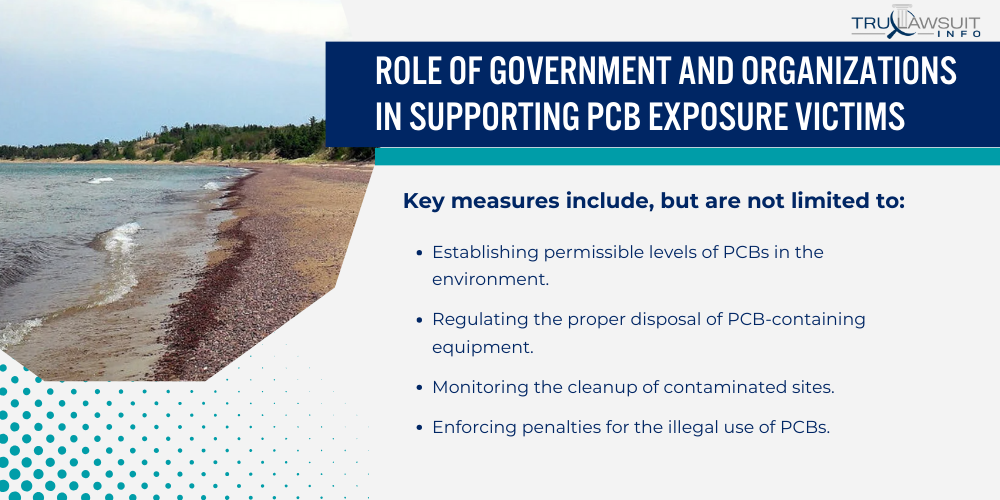
Their actions can significantly influence the well-being of affected individuals and communities.
Legislation and Regulations to Protect Public Health
To mitigate the health risks associated with PCB exposure, governing bodies have enacted various regulations.
For example, the EPA banned the production of PCBs in 1979 under the Toxic Substances Control Act.
Key measures include:
- Establishing permissible levels of PCBs in the environment.
- Regulating the proper disposal of PCB-containing equipment.
- Monitoring the cleanup of contaminated sites.
- Enforcing penalties for the illegal use of PCBs.
Fact-driven legislation aims to safeguard populations.
For example, the EPA’s rules on PCB cleanup and disposal provide a framework to protect public health.
Funding for Research and Health Monitoring Programs
Financial support is crucial for advancing our understanding of PCB-related health effects and improving treatments.
Funding efforts encompass:
- Grants for scientific studies on PCB toxicity.
- Financial resources for health surveillance programs.
- Support for the development of new diagnostic methods.
- Allocation of funds towards the creation of educational materials on PCBs.
The Agency for Toxic Substances and Disease Registry often collaborates with other institutions to fund and conduct essential research.
Collaboration with Healthcare Providers and Community Organizations
Inter-agency cooperation optimizes the assistance to those affected by PCBs.
Such collaboration includes:
- Partnering with healthcare systems to improve patient tracking and care.
- Working alongside community organizations for support services.
- Organizing joint initiatives to aid populations living in contaminated areas.
- Engaging with local authorities to tailor interventions to community needs.
These partnerships can often lead to more comprehensive and personalized care, like the support efforts by local health departments.
Public Outreach and Education Campaigns
Education is a powerful tool to prevent new cases of exposure and inform victims about their options.
Outreach efforts are designed to:
- Inform the public about the dangers of PCBs.
- Teach communities how to reduce exposure risks.
- Share resources available to PCB-exposed individuals.
- Highlight ongoing research and findings on PCBs.
The EPA’s fact sheet on PCBs is an example of materials created to raise awareness and educate the public.
TruLaw: The #1 PCB Exposure Victims Lawyer
TruLaw stands at the forefront of legal support for victims of PCB exposure, providing comprehensive and compassionate services with a strong commitment to advocacy.
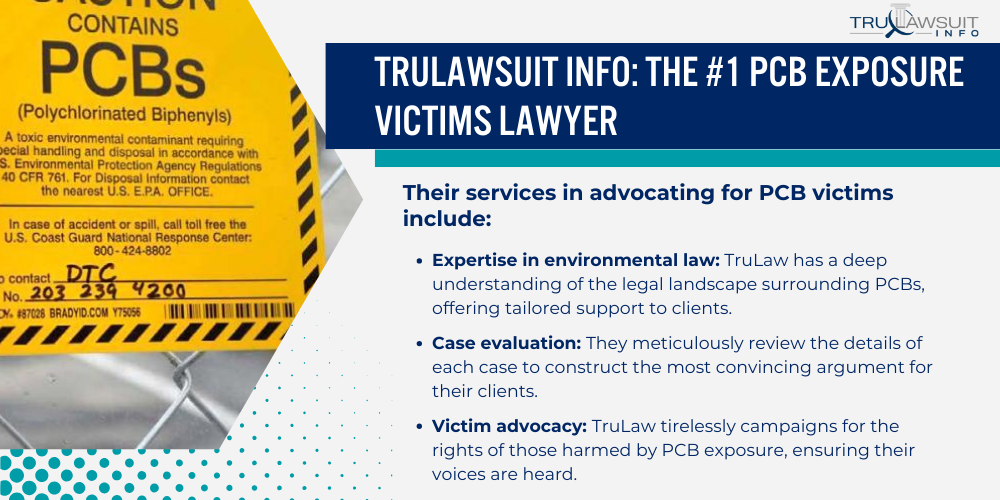
Their focus is on ensuring that justice is accessible to those impacted by PCBs without placing a financial burden on them from the outset.
No Upfront Cost For PCB Exposure Victims
TruLaw understands the financial strain that legal action can often entail.
They stand by a clear commitment to supporting PCB exposure victims without the burden of upfront costs.
This allows individuals to seek the justice they deserve, backed by a firm that is both knowledgeable and skilled in this area of law.
Their services in advocating for PCB victims include:
- Expertise in environmental law: TruLaw has a deep understanding of the legal landscape surrounding PCBs, offering tailored support to clients.
- Case evaluation: They meticulously review the details of each case to construct the most convincing argument for their clients.
- Victim advocacy: TruLaw tirelessly campaigns for the rights of those harmed by PCB exposure, ensuring their voices are heard.
- No financial risk: Clients are not charged upfront fees, providing them with confidence and peace of mind as they seek redress for their suffering.
As they continue to support individuals affected by PCB exposure, TruLaw remains a leading name for those in need of passionate legal support with a promise of no upfront cost and thorough PCB victim advocacy.
Frequently Asked Questions
-
Symptoms of PCB exposure can vary depending on the level and duration of exposure. Common symptoms include skin conditions resembling acne or rashes, eye irritation, respiratory issues, digestive problems, and changes in blood and urine.
-
PCBs are persistent organic pollutants that can remain in the environment for long periods, allowing human exposure through various routes. This includes eating contaminated food, inhaling air near hazardous waste sites, using old electrical equipment containing PCBs, and coming into physical contact with PCB-contaminated soil or water.
-
The health effects of PCB exposure can be severe and are well-documented. They include immune system suppression, reproductive disorders, endocrine system disruptions, increased risk of certain cancers, and neurobehavioral and cognitive changes, especially in children. Further insights into health effects are available through the CDC.
-
Exposure limits for PCBs are set by regulatory agencies to protect human health. Different organizations, such as the EPA, OSHA, and FDA, have established guidelines to ensure safety in various settings based on thorough research detailed in the EPA’s policy documents.
-
The effects of PCBs on human health can be varied and potentially long-lasting. Some of these effects include long-term skin conditions, liver damage and changes in liver function, possible neurotoxic effects, and potential developmental issues in children exposed in utero. You can find more information about these effects on the EPA’s dedicated PCB webpage.
-
Due to bioaccumulation in the food chain, people who consume large quantities of fish from contaminated waters and those who work in specific occupations or live near certain locations can face higher exposure risks.

Attorney Jessie Paluch, founder of TruLawsuit Info, has over 25 years of experience as a personal injury and mass tort attorney, and previously worked as an international tax attorney at Deloitte. Jessie collaborates with attorneys nationwide — enabling her to share reliable, up-to-date legal information with our readers.
Legally Reviewed
This article has been written and reviewed for legal accuracy and clarity by the team of writers and legal experts at TruLawsuit Info and is as accurate as possible. This content should not be taken as legal advice from an attorney. If you would like to learn more about our owner and experienced injury lawyer, Jessie Paluch, you can do so here.
Fact-Checked
TruLawsuit Info does everything possible to make sure the information in this article is up to date and accurate. If you need specific legal advice about your case, contact our team by using the chat on the bottom of this page. This article should not be taken as advice from an attorney.
You can learn more about the PCB Exposure Lawsuit by visiting any of our pages listed below:
Here, at Tru Lawsuit Info, we’re committed to helping victims get the justice they deserve.
To do this, we actively work to connect them with attorneys who are experts in litigating cases similar to theirs.
Table of Contents
Tru Lawsuit Info is a reliable source of information about issues that may affect your health and safety, such as faulty products, data breaches, and environmental hazards.
Our team of experienced writers collaborates with medical professionals, lawyers, and advocates to produce informative articles, guides, and other resources that raise awareness of these topics.
Our thorough research provides consumers with access to reliable information and updates on lawsuits happening around the country. We also can connect consumers with attorneys if they need assistance.
Here, at Tru Lawsuit Info, we’re committed to helping victims get the justice they deserve.
To do this, we actively work to connect them with attorneys who are experts in litigating cases similar to theirs.
